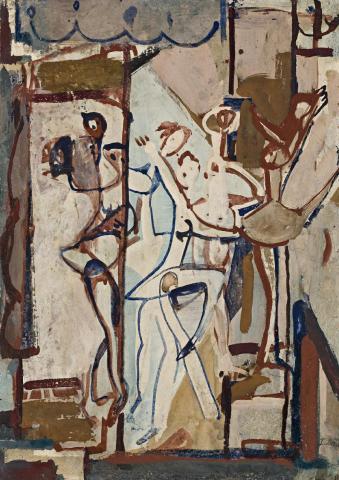CIRCUS, c.1956
Ian Fairweather
gouache on cardboard
52.0 x 36.5 cm
signed with initials lower right: ‘I.F’
Macquarie Galleries, Sydney
Dr D. Smythe, Sydney
Barry Stern Gallery, Sydney
W.R. Burge Collection, Sydney, acquired from the above in 1971
Christie's, Sydney, 6 March 2006, lot 17 (as 'The Dance')
Private collection, Sydney
15 Guinea Pictures, Macquarie Galleries, Sydney, 25 June - 7 July 1958, cat. 8 (titled 'Circus')
Ian Fairweather, Museum of Modern Art of Australia, Melbourne, 19 August - 29 August 1958, cat. 10
Circus, c.1956 is a painting full of dance movement within the big top, its numerous verticals supporting the scalloped canvas tent edges framing the upper part of the composition. Highlighted by a spotlight of pale blue, the middle group of white figures advance while those outlined in ochre and black recede, creating a marvelous sense of movement in performance. Paradoxically the moment seems frozen, as in a photograph, the fraction of a second between stillness and dance captured by the artist to add to the interplay and illusion of the one being the other. Subject apart, it has an affinity to the similarly sized gouache, The Circus, c.1956 in the collection of the National Gallery of Victoria, Melbourne. Once again the principal interest is captured movement expressed through form and a more vivid range of colours. Murray Bail in his definitive study on Fairweather, has pointed out the affinity between Melbourne's The Circus and (Chinese Scene), c.1956 (private collection), which he describes as 'a fine example of Fairweather's subdued colour.'1 The same can be said of the effectively limited palette in our Circus. It is likewise close to (Chinese Scene) in its compositional complexities, giving it a pictorial depth of the circus ring. Moreover, Fairweather's calligraphic mastery suggests the pirouette and other balletic modes while emphasizing the performance that takes place across the picture plane. Both evoke the atmosphere of the scene, as in other thematically allied paintings of the time, (Merry-Go- Round) c.1956, in the National Gallery of Victoria, and Trotting Race, c.1956, in a private collection.
1. Bail, M., Ian Fairweather, Bay Books, Sydney, 1981, p. 124
DAVID THOMAS
